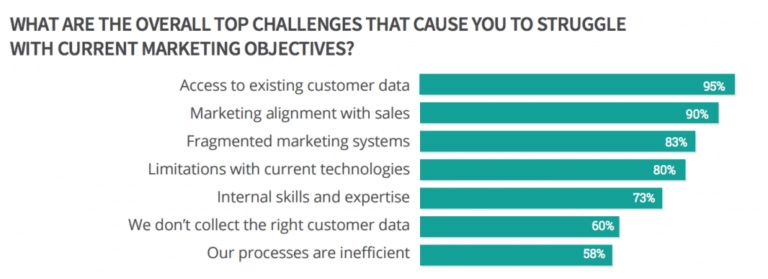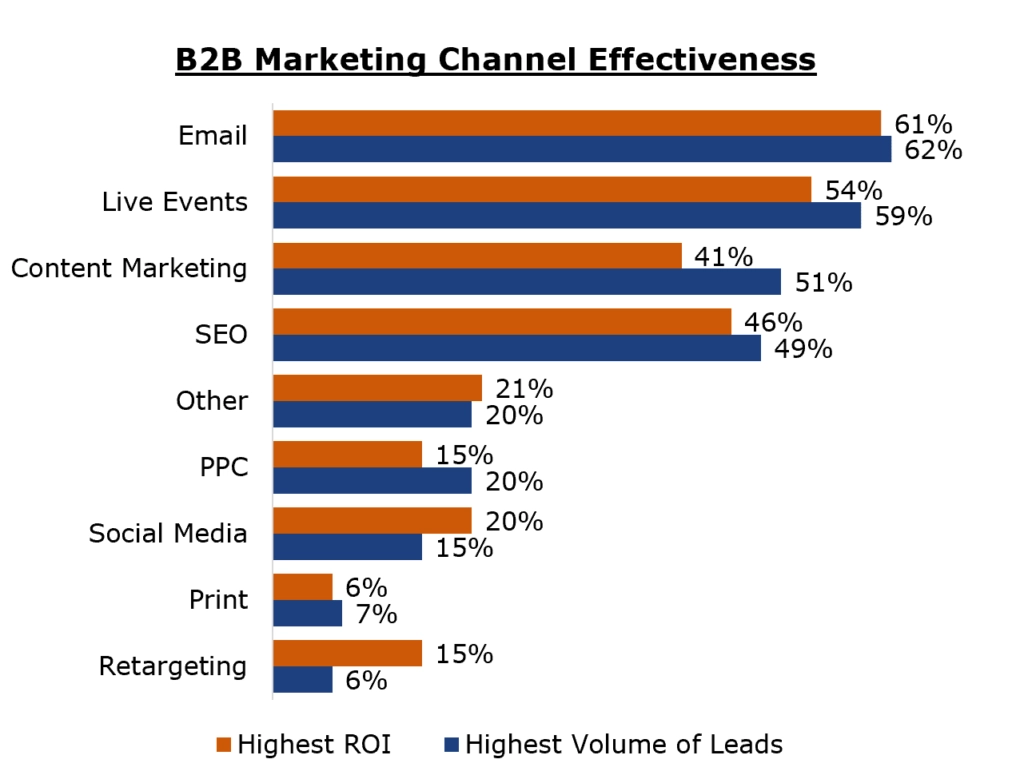
Introduction
Every year, companies lose $1 trillion in costs due to misalignment between sales teams and marketing teams. The flip side of this is that B2B companies that succeed in aligning their sales and marketing teams increase their revenue by up to 208% each year. In addition to revenue growth, such companies enjoy higher staff retention rates, grow faster and perform better in deal closing just by aligning sales and marketing functions.
But aligning these two functions is not a walk in the park. Available data shows that creating alignment between sales and marketing teams remains a major challenge for 90% of B2B companies.

Source: Spotio
In the article, we explore seven easy steps that B2B companies take to align their sales and marketing teams throughout the sales funnel in 2020. But before we delve into this, let’s look at what sales and marketing alignment entails.
Sales and Marketing Alignment – What Does It Look Like?
Most people view alignment between sales and marketing teams as boosting collaboration between the two functions. But it is more than that. At the core of aligning these two teams is the need to re-envision the sales funnel and view it as a revenue cycle that integrates both sales and marketing activities in all stages.
The best alignments are those that leverage data-focused approaches and long-term vision to support the short-term targets that sales reps have and solve the problems they encounter. Often, this kind of alignment takes place in three main fronts:
1. Lead Qualification
Sales and marketing teams need to agree on a criterion for qualifying leads. Agreeing on the key attributes of qualified leads enables the teams to standardize their communication language and monitor key metrics in the revenue cycle. This results in streamlined communication between the two teams and also fosters collaboration as each team pursues the set goals.
2. Inter-Departmental Communication
To solidify cooperation and alignment between marketing and sales teams in a B2B company, open and regular communication is necessary. Maintaining open communication enables the two teams to agree on important aspects of marketing content and the frequency with which it should be done. It also enables them to keep reviews or check-ins focused on future growth and inter-departmental collaboration.
3. The Sales Process
Sales and marketing teams that are well aligned have clear procedures of pushing leads down the sales or revenue funnel. These procedures could include clarifying how new staff who join the teams are trained and how both teams leverage technology.
The teams also clarify important processes for tracking bottom of the funnel leads. Such processes could include checking intent data like whether leads complete demos and consistency and accuracy of lead data. Thinking about these processes enables sales and marketing teams contextualize each lead in the sales funnel and communicate with each other.
Steps for Aligning Sales and Marketing Throughout the Sales Funnel
Step 1: Get Executive Buy-In
To ensure that sales and marketing teams work together, you need to start by communicating the importance of aligning the two teams. In addition to this, ensure that you make their alignment part of your business initiative by getting the buy-in of the top management. The best way to get this buy-in is to make the executive part of the initial meeting that you hold with the sales and marketing leaders.
In this meeting, build a case for the need to align the two functions by using data to demonstrate the cost of misalignment to the company. Some metrics that you need to highlight to get executive buy-in include:
- Marketing leads that the sales team is able to follow up – A low rate could mean that the marketing team is not generating high quality leads or the sales team is not doing a good job when it comes to following leads up
- Marketing leads that convert – This metric gives you an idea of the quality of leads the marketing team generates. If the sales team does a good follow-up job but few leads are converted, it means the leads that your marketing team is generating are of low quality
- Number of touches that sales teams have before converting prospects – This metric looks at the number of times sales or marketing teams communicate with prospects before an actual purchase is made. If this number is low, the marketing team is generating high value leads and vice versa
After demonstrating the gap between sales and marketing teams, demonstrate the difference it would make if the two teams are aligned. With the B2B executive onboard, it’s time to cascade alignment efforts to the rest of the team – which takes us to the next step.
Step 2: Maintain Open Communication Between Sales and Marketing Functions
Statistics show that only 30% of CMOs in B2B companies have clear programs or processes for prioritizing sales and marketing alignment. Considering the important role that alignment between the two departments plays in revenue growth, You can keep track of gross and net revenue along with all your expenses using an online accounting software. The best way to bridge the divide between sales and marketing functions is to develop and document an open communication strategy.
The starting point for such a strategy is holding meeting for teams in both departments to agree on important issues including:
- Clarifying what marketing teams need from sales teams and what sales teams need from the marketing teams
- Agreeing on what high quality leads and low-quality leads look like
- Agreeing on what the standard revenue or sales cycle looks like – from the beginning to the end
- Agreeing on the buyer personas that each team would work with
- Determining whether leads have the right understanding of the services or products the company offers before they talk to sales teams
- Identifying areas that each team can improve
After clarifying these issues, the two teams should continue meeting regularly for share reports, discuss progress and exchange ideas on how to improve the sales and marketing alignment further.
Step 3: Clarify the Target Audience
Every business must have a clear target audience for its products or services. For B2B companies, the process of clarifying a target audience involves developing target market profile and creating buyer personas. Often, these are informed by best practices and data from existing customers. Most companies view this process as a marketing function and tend to leave the sales team out of it.
Often, this presents a challenge because sales teams are at the heart of the selling process – they interact directly with customers. As such, they have intimate knowledge about deals they have closed previously that marketing teams can enrich with data-proven best practices, industry analytics or information about changing customer behavior. At this point, B2B companies can align sales and marketing teams by tapping each team’s strengths. This enables the two teams to build solid market profiles and buyer personas that reflect real customer behavior changes and build momentum from previous deals.
Buyer personas are important to have because:
- They help companies understand their customers better so they can market their products to them effectively
- They enable companies to identify personas that they should not be marketing to
- They help companies to understand how different personas interact with them along their buyer journey and when they do so
- They inform decisions to develop new services or products
Step 4: Develop Shared Goals
A major reason for misalignment between sales and marketing teams is because each team pursues its own goals and uses varying metrics to track progress. This means that the sales teams do not know the kind of buyers to target because they have no idea, they type of leads marketing teams are generating. This is why it is important that the two teams work together to develop shared goals and agree on the metrics they’ll use to track those goals. To do this, the two teams should work together to:
- Define Qualified Leads: Agree on specific definition of sales qualified leads and marketing qualified leads to avoid misinterpretation or misunderstanding
- Develop a Leads Conversion Strategy: Collaborate in crafting a strategy for turning leads into prospects, then prospects into revenue. This process will enable them to identify key factors for scoring leads. These could include firm information like size, location, industry and tech stack
- Visualize the Sales Funnel: Take a full view of the sales funnel including the cost of converting leads and conversion rates. This means the two teams should analyze lead sources, conversion costs and rates on a regular basis. They should also analyze campaigns to see which ones generate more leads and replicate them.
- Report and Evaluate Progress: Have the teams report progress and evaluate performance on a regular basis. Shared dashboards can make the reporting process faster and easier.
Step 5: Prepare a Service Level Agreement (SLA)
To actualize your sales and marketing alignment, you will need to prepare a service level agreement. This agreement is signed between the sales and marketing departments outlining what each team is responsible for. Studies show that B2B companies that put an SLA in place are:
- 21% likely to get higher budgetary allocation than those that don’t
- 34% likely to increase their year-on-year return on investment than those that don’t
- 31% likely to hire more salespeople to meet rising demand
The best time to agree on these responsibilities is during the initial meeting held between leaders of the two departments. The definitions, strategies and goals discussed in step three above need to be included in the agreement and should be used to set performance metrics and team expectations.
Examples of marketing goals can be to increase the number of qualified leads, create opportunities or increase revenue. On the other hand, sales goals can be to increase follow-up frequency or percentage of leads that the team follows up.
Step 6: Evaluate Effectiveness of Lead Channels

Source : Ventureharbour
Lead channel evaluation should be undertaken particularly where the company is spending money to generate leads. For instance, if you are using paid content syndication, display advertising or social media marketing, you need it is important to check the conversion rate of leads that come through each of these channels.
Some channels bring in numerous leads but very few of those convert – this means the return on investment for the business is very low. Most marketing metrics focus on lead volumes, clicks and views. However, sales and marketing teams need to look beyond this and focus on how these leads are translating to revenue.
Step 7. Identify and Retarget Cold Opportunities
Working together, marketing and sales teams can identify and retarget cold leads. However, to be successful, this strategy requires the two teams to be well aligned in terms of process as well as progression.
In this step, the two teams use account-based marketing to retarget cold leads. The marketing team takes a lead in undertaking re-marketing activities like:
- Lead nurturing email campaigns
- Display ads
- Direct mails
On the other hand, sales teams make follow-up calls:
Final Thoughts
To align sales and marketing teams throughout the sales funnel in 2020, B2B companies need to change their mindset on how these two teams have conventionally moved quality leads through the revenue or sales funnel. The most success companies will be those that take a ‘hands on’ approach in keeping the two teams engaged throughout the sales process.
Our blog
Latest blog posts
Tool and strategies modern teams need to help their companies grow.

B2B media buying has undergone a fundamental shift. What was once a straightforward, ...

It is for fact that today's buying environment demands more. With longer sales cycles...

To build a marketing strategy that drives real results, you need more than creative i...







